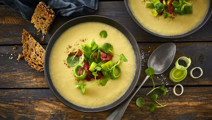
Crab soup

Instructions
Bread croutons
Questions about crab soup
A deliciously tasty crab soup is great to have on a cold day, but also as a starter to any meal. See below for more information about this tasty soup.
Ingredients
Crab soup
|
Large tomatoes (approximately 125 g)
|
2 |
|---|---|
|
Butter
|
25 g |
|
Onions (approximately 150 g)
|
2 |
|
Garlic cloves
|
2 |
|
Freshly caught crabs (10-15 pieces depending on size)
|
500 g |
|
Concentrated tomato purée
|
1 tbsp |
|
Paprika
|
1 tsp |
|
Apple juice
|
200 ml |
|
Water
|
750 ml |
|
Double cream
|
150 ml |
|
Freshly squeezed lemon juice
|
1 tbsp |
|
Coarse salt
|
1 tsp |
|
Freshly ground pepper
|
Bread croutons
|
Bread (loaf)
|
150 g |
|---|---|
|
Butter
|
25 g |
|
Coarse salt
|
½ tsp |
For serving
|
Crab meat or cooked, peeled prawns
|
200 g |
|---|---|
|
Fresh basil
|
1 dl |
|
Lemon, cut into wedges
|
1 |
A soup with a pinch of seaside
Packed full of flavour, crab soup can bring the aroma, sight, sound and taste of the seaside right to your dinner table. The sweet and slightly salty taste of these crawly crustaceans are brought to life with the richness of the onions and ground vegetables, the spice of the paprika and the citrusy essence of lemons. It’s then balanced to perfection with a range of herbs, spices and seasonings.
You don’t always need to be beside the seaside to enjoy the taste of the seaside!
Emptying your catch – tips for preparing crab at home
Preparing crabs at home carries a pinch of risks, so it’s important to know what you’re doing. If you’re unsure, it’s always best to ask your local fish monger for help to prepare your crabs.
However, there’s nothing like fresh crab meat, and if you’re prepared to take the plunge at home, here are some simple steps to preparing your crab at home:
- First things first, avoid getting pinched by ensuring your crab is safely tied up.
- Clean your crabs by rinsing them thoroughly with cold water.
- Bring a pot of water to the boil, adding seasoning for extra flavour.
- Add the crabs and simmer on a low heat until the shells have turned into their characteristic bright red colour. Leave the pot to cool.
- Crack the shells with a nutcracker or large knife to remove the meat. Rinse thoroughly again before adding the meat to your crab soup.
Preparing store-bought crab (if all you caught was a boot)
While freshly caught crab is the best way to bring out the freshness, flavour and nutritional value of your crab soup, not everyone lives close to the seaside, and certainly not everyone has the time to catch crab at weekends.
Store-bought crab is a convenient, readily available and more affordable alternative to fresh crab when making your crab soup. However, as is often the case with goods that are processed and packaged, you may have to accept some compromises when it comes to taste. Try experimenting with both and see which variant your taste buds – and budget – prefer!
Herbs and spices that go well with crab
While our menu uses seasoning such as paprika, lemon, salt and pepper, there are many other herb and spice options that you can add to bring out the flavour in your crab soup.
Our top pick is dill, an especially good pairing with the delicate sweetness of crab. Other popular herbs and spices include thyme, basil, and parsley. You may also want to add seasoning mixes such as the classic old bay seasoning. If you want to add a touch of creole to your crab soup, you can try spicing it up with paprika, or even chillies and hot sauces such as Tabasco.
Keep in mind that when seasoning a little goes a long way, and it’s best to add little by little.







